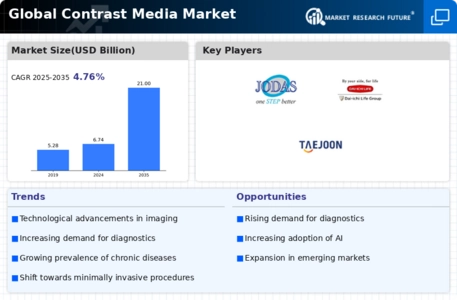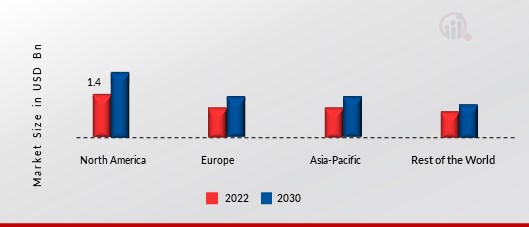Contrast Media Size
Contrast Media Market Growth Projections and Opportunities
The increased interest in diagnostic imaging is driving the contrast media industry. Medical imaging technologies like X-rays, CT, and MRI are becoming increasingly important. Thus, contrast media that improve imaging study visibility and clarity are in demand. Diagnostic imaging is becoming more important as chronic illnesses including cardiovascular disease, cancer, and neurological issues become more common. Contrast media is an essential part of imaging modalities for proper diagnosis and monitoring of many medical disorders. New imaging methods including high-resolution imaging and improved modalities are growing the contrast media industry. This is due to imaging technology advancements. Functional magnetic resonance imaging (MRI) and dual-energy CT are increasing the requirement for contrast agents. These advances improve diagnosis. The rising number of elderly individuals worldwide drives the industry. Due to extensive age-related disorder screening among the elderly. Contrast media is often used in imaging examinations to diagnose and treat disorders in older people. Compared to other causes of mortality and illness, cardiovascular disorders are still common. Due to the increased frequency of heart-related illnesses, more sophisticated diagnostic imaging methods are needed, which increases the requirement for contrast media in angiography and cardiac CT scans. The need for less-invasive medical procedures is a major industrial factor. Contrast media guide and improve minimally invasive therapies, driving their market. In cancer imaging, contrast media are widely employed to detect and characterize malignancies. Oncology contrast-enhanced imaging investigations are needed due to cancer's rising incidence and the need of early detection. This affects corporate market dynamics. Pharmaceutical businesses, imaging equipment makers, and academic institutions are working together to expand the market. Collaborations enable the development of novel contrast agents, imaging methods, and therapeutic uses. The market's stability is due to strict contrast media effectiveness and safety regulations. Regular developments in contrast agent compositions that comply with safety criteria and minimize adverse effects boost the industry's validity and popularity. Global healthcare infrastructure development drives the contrast media market. Increased availability of advanced diagnostic imaging technologies in developed and emerging nations is boosting contrast media demand, impacting market developments. Growing availability of these technologies drives this desire. The market's reaction to emerging infectious illnesses is another factor. Contrast media is vital for diagnosing and treating infectious diseases. Imaging studies help control public health concerns.








Leave a Comment